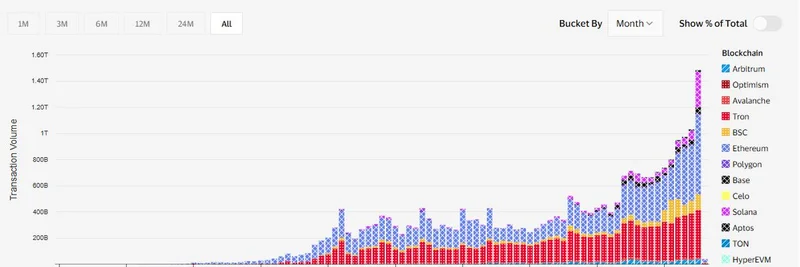Brian Armstrong, the CEO of Coinbase, recently shared a compelling perspective on X about the future of stablecoins in the U.S. His post dives into why allowing stablecoin holders to earn interest—termed "onchain interest"—could be a win-win for consumers, the global economy, and even the dominance of the U.S. dollar. Let’s break down his argument and explore what this could mean for the crypto space.
What Are Stablecoins and Onchain Interest?
Stablecoins are cryptocurrencies designed to maintain a steady value by being pegged to assets like the U.S. dollar. For example, USDC, a popular stablecoin, is backed 1:1 by USD reserves, often held in low-risk investments like short-term U.S. Treasuries. These reserves generate interest, but right now, that interest typically stays with the issuer rather than being passed on to the stablecoin holder.
Armstrong introduces the concept of "onchain interest," which would allow stablecoin holders to directly earn the interest generated from those reserves. Think of it like an interest-bearing checking account, but powered by blockchain technology. This isn’t happening yet because of regulatory barriers, which Armstrong argues need to change.
Why Onchain Interest Matters for U.S. Consumers
Armstrong highlights a stark reality: the average U.S. consumer is losing money in traditional savings accounts. In 2024, the average savings account yield was just 0.41%—sometimes as low as 0.01%—while the Federal Funds rate, a benchmark for market yields, averaged 4.75%. With inflation at around 3%, this means consumers faced a real loss in purchasing power of about 2.5%. In simpler terms, the money in your savings account isn’t keeping up with rising prices, thanks to middlemen like banks taking the lion’s share of the interest.
By enabling onchain interest, stablecoins could offer consumers direct access to market-rate yields—think 4% or more. Instead of earning a measly 0.01% on your savings, you could hold a stablecoin like USDC and earn a return that actually helps your money grow. This could be a game-changer for everyday Americans struggling to save.
A Global Financial Opportunity
The benefits don’t stop at U.S. borders. Armstrong points out that billions of people worldwide are underbanked, meaning they lack access to traditional financial services. Many also suffer from volatile local currencies, where savings can lose value overnight due to inflation or economic instability. Stablecoins, especially those pegged to the U.S. dollar, offer a lifeline by providing access to a stable currency—and with onchain interest, they could also earn a return on their savings.
All someone needs is an internet connection to access this system. No bank branch visits, no hefty fees for remittances or overdrafts—just a transparent, global financial network powered by crypto. This could democratize financial access in a way traditional banking never has, especially in emerging markets where stable currencies are hard to come by.
Boosting the U.S. Economy and Dollar Dominance
Stablecoins are already major players in the U.S. Treasury market. They hold more Treasuries than most countries, and Armstrong predicts they could become the largest holders in a few years. By onboarding global users to USD-backed stablecoins, they’re effectively extending the dollar’s dominance in a digital world. More people holding stablecoins means more demand for U.S. Treasuries, which strengthens the U.S. economy.
If consumers earn interest on their stablecoins, they’ll have more money to spend, save, or invest—fueling economic growth not just in the U.S., but in every local economy where stablecoins are used. Armstrong warns that if the U.S. doesn’t act, it risks missing out on billions of new USD users and trillions in potential cash flows, potentially ceding ground to other countries that embrace this innovation.
The Regulatory Roadblock
So, why isn’t this happening already? The technology exists, but the law hasn’t caught up. Unlike traditional interest-bearing accounts, stablecoins don’t currently have exemptions under U.S. securities laws that would allow issuers to pay interest without facing heavy disclosure requirements and tax implications. Armstrong argues this is unfair—stablecoins should be treated like savings accounts, not securities, when it comes to paying interest.
This regulatory gap has been a hot topic, especially with a pro-crypto administration and Congress working on stablecoin legislation as of early 2025. For example, the House Financial Services Committee has been discussing stablecoin bills, as noted in a recent CNBC article. Armstrong sees this as a golden opportunity to level the playing field and ensure consumers get a fair share of the profits.
A Call for Fair Competition
Armstrong’s core message is about fairness and competition. He believes the government shouldn’t favor one industry—like traditional banks—over another, such as crypto companies. Both should be allowed to share interest with consumers, fostering a free market where innovation thrives. If stablecoins can offer better yields, it’ll push banks to up their game, ultimately benefiting consumers.
The responses to Armstrong’s post on X show a mix of optimism and curiosity. Users like OrdinalVerse are hopeful for follow-ups, while others like The Garden see this as a game-changer for leveling the financial playing field. The crypto community seems eager for this shift, recognizing its potential to reshape how we think about money.
What’s Next for Stablecoin Legislation?
Armstrong’s post comes at a pivotal moment. With new stablecoin legislation in the works, the U.S. has a chance to lead the way in crypto innovation—or risk falling behind. Other regions, like the EU with its MiCA regulation, are already setting frameworks for stablecoins, categorizing them into types like electronic money tokens (EMTs) and asset-referenced tokens (ARTs). The UK, meanwhile, is prohibiting interest on stablecoins under its proposed rules, a stark contrast to Armstrong’s vision.
The stakes are high. Allowing onchain interest could shift profits from exchanges and platforms to consumers, as Ben Kurland of DYOR noted in the CNBC piece. It could also redefine financial access for billions, strengthen the U.S. economy, and cement the dollar’s role in a digital future. But it all hinges on whether lawmakers can create a regulatory framework that embraces innovation without stifling it.
What do you think—should stablecoins be allowed to pay interest like a savings account? Let’s keep an eye on how this debate unfolds in 2025.


